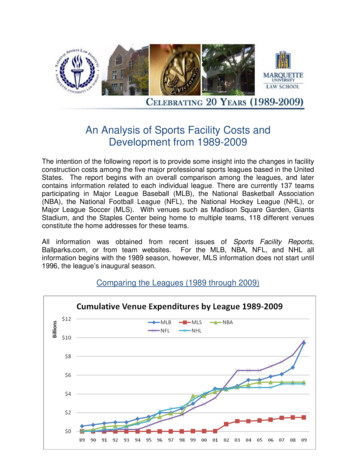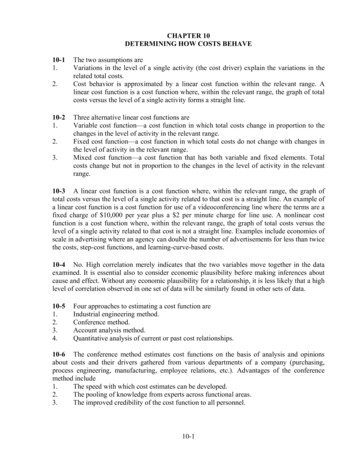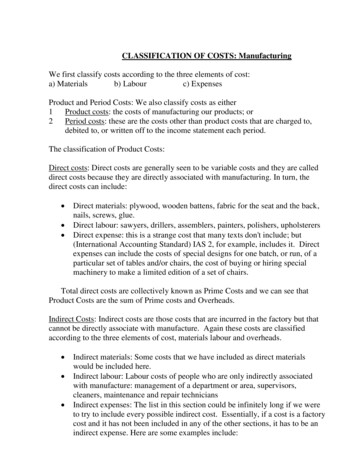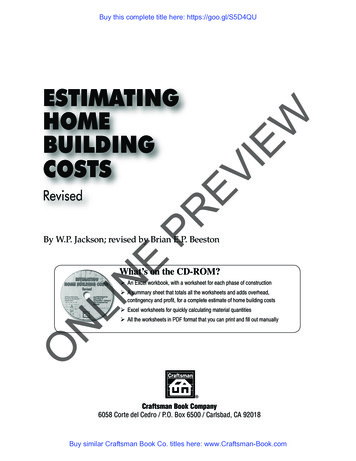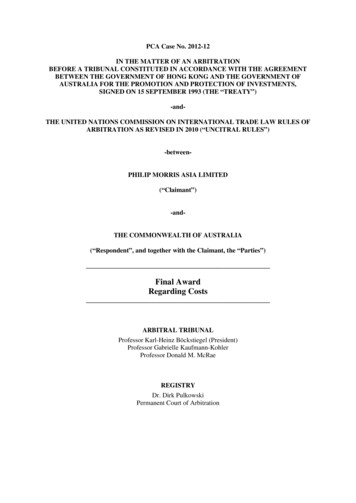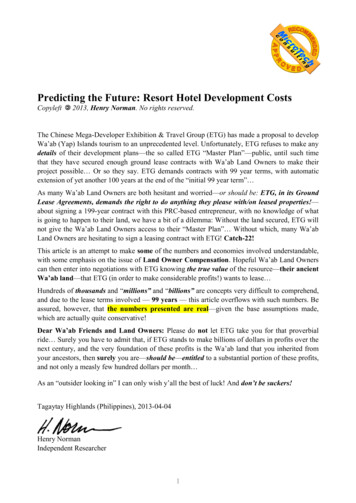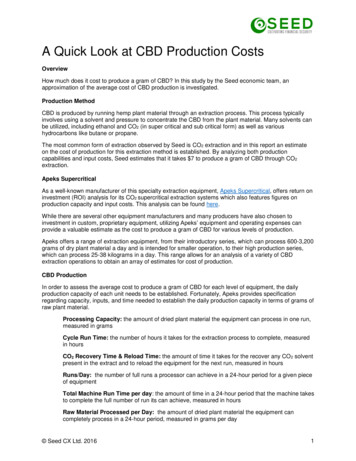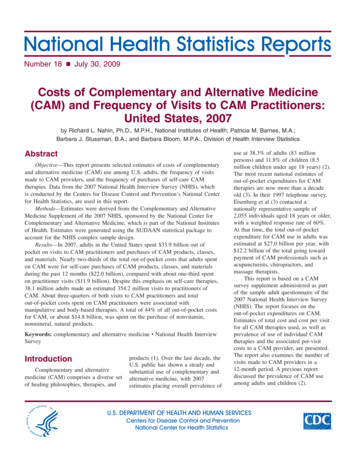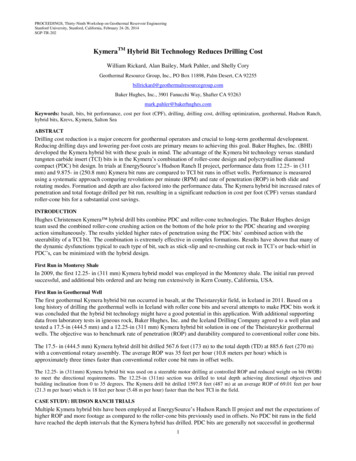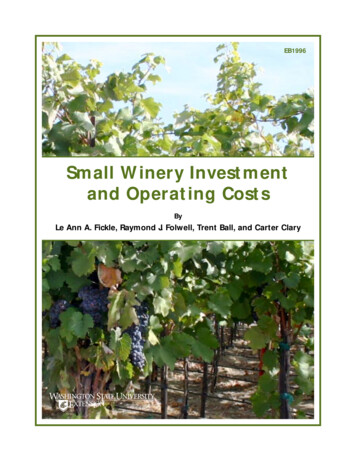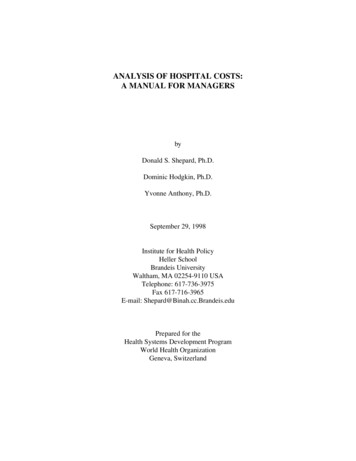
Transcription
ANALYSIS OF HOSPITAL COSTS:A MANUAL FOR MANAGERSbyDonald S. Shepard, Ph.D.Dominic Hodgkin, Ph.D.Yvonne Anthony, Ph.D.September 29, 1998Institute for Health PolicyHeller SchoolBrandeis UniversityWaltham, MA 02254-9110 USATelephone: 617-736-3975Fax 617-716-3965E-mail: Shepard@Binah.cc.Brandeis.eduPrepared for theHealth Systems Development ProgramWorld Health OrganizationGeneva, Switzerland
Table of ContentsACKNOWLEDGMENTSIVCHAPTER 1: INTRODUCTION51.1Purpose of the Manual51.2Cost Finding and Analysis as Management Tools5CHAPTER 2: COMPUTATION OF UNIT COSTS USING LINE-ITEM EXPENDITUREDATA72.1. Define the Final Product of the Cost Analysis72.2. Define Cost Centers102.3. Identify the Full Cost for Each Input112.4 Assignment of Inputs to Cost Centers182.5. Allocation of All Costs to Final Cost Centers212.6. Computing Unit Cost for Each Cost Center322.7. Reporting Results33CHAPTER 3: USING COST DATA TO IMPROVE MANAGEMENT OF ANINDIVIDUAL HOSPITAL343.1 Introduction343.2 Cost Center or Department Level343.3 Hospital Level403.4 Hospital Revenues43CHAPTER 4: USING COST DATA TO IMPROVE MANAGEMENT OF A HOSPITALSYSTEM454.1 Introduction454.2 Estimating Volumes in a Hospital System454.3 Allocation of a Budget among Hospitals514.4 Applications to Improve Hospital Efficiency52ii
4.5 Refining the Hospital’s Role in the Health SystemREFERENCES55581. Methodology of cost analysis582. Country studies583. Other Studies60APPENDIX I: TABLES FOR COMPUTING UNIT COST AT 'HOSPITAL X'62APPENDIX II: STEP-DOWN ALLOCATION USING DIRECT COST66APPENDIX III: EXAMPLES OF STUDY SUMMARY SHEETS69APPENDIX IV. TABLE OF ANNUALIZATION FACTORS73APPENDIX V. EXERCISES74iii
ACKNOWLEDGMENTSWe are indebted to many people for their generosity in providing us time, advice, knowledgeand relevant background documents. We particularly thank Joseph Kutzin, the WHO official whocommissioned this work, who gave us copies or leads on numerous relevant studies and invaluablefeedback on an earlier draft. We also thank Andrew Creese, Guy Carrin and Claudio Politi, both fromWHO/CIO, for their helpful comments on an earlier draft. We are grateful to the authors of severalstudies referenced throughout the document for making their work available to us. Finally, we wish togratefully acknowledge financial support from the World Health Organization and contributors to itsspecial programs, namely the Danish International Development Agency (DANDIDA) and the U.S.Agency for International Development (USAID).We benefited from field tests in Bangladesh and Zimbabwe coordinated by JamesKillingsworth and Tom Zigora and supported by WHO and the British Department of Finance forInternational Development.iv
CHAPTER 1: INTRODUCTION1.1Purpose of the ManualAccording to a major World Bank study of public hospitals (Barnum and Kutzin, 1993), theshare of public sector health resources in developing countries consumed by hospitals ranges from 50to 80 percent. This manual seeks to help managers make the best use of these resources. By betterunderstanding the costs of various activities, managers can improve the efficiency of various hospitaldepartments, as well as hospital systems as a whole. Finally, the data can help national policy makersdecide which curative care is best delivered in hospitals, and to examine the tradeoffs among variouspreventive, primary curative, and secondary curative services.This manual is written for all officials involved with the management and funding of hospitals indeveloping and transitional economics. Thus, our target audience includes hospital managers (bothfinancial and programmatic), public sector managers at the district, regional and national levels of thehealth system, and persons responsible for non-profit and private hospital systems.The type of information available for cost analysis varies substantially across countries andhospitals, from extensive to rudimentary. Hospitals vary in the extent to which costs are allocated tospecific hospital departments, and the accuracy with which such allocations are recorded. In light ofthis, we spell out alternative approaches wherever possible, and suggest what approaches can be takenwhen information is incompleteThis manual provides a framework for both deriving and analyzing hospital costs. Chapter 2shows how to compute unit costs. Since often times data may be incomplete, the chapter also showshow cost allocations among cost centers can be imputed from staffing data or approximated from otheravailable information. Complementary information from each department can be obtained frominterviewing hospital personnel (e.g., staff time, wages, allowances, supplies, space occupied, andactivities performed), or from extracting data from management information systems or medicalrecords (e.g., amounts of care provided). Chapters 3 and 4 apply knowledge gained from the previouschapters by discussing ways in which cost data can be utilized at the level of the individual hospital(chapter 3) or the hospital system (chapter 4). In many hospitals in developing countries, particularlysmaller ones, costs may not be reported at all by individual departments, or that reporting may be veryincomplete or arbitrary. Thus, chapter 4 shows how to compute unit costs when line item data arecompletely missing or not usable. Since managers of various units of the health system are concernedwith different parts of the health system, we expect that many readers will consult this manualselectively and concentrate only on the components that apply to them. The manual has been used inand benefited from workshops in Bangladesh and Harare. Appendix V contains case studies based onthose workshops. We found that the workshop manual proved a stimulating format for introducing thetopics in this manual, and encouraging managers to think more broadly about strengthening theirinstitutions. These case studies can be used to facilitate that process.1.2Cost Finding and Analysis as Management ToolsIn both developing and industrialized countries, hospitals are viewed as vital and necessarycommunity resources that should be managed for the benefit of the community (Institute for HealthPolicy Studies, 1996; World Health Organization 1987, 1992; Van Lerberghe and Lafort 1990). As5
such, hospital management has a responsibility to the community--to provide health care services thatthe community needs, at an acceptable level of quality, and at the least possible cost. Cost finding andanalysis can help departmental managers, hospital administrators, and policymakers to determine howwell their institutions meet these public needs.Cost finding and cost analysis are the technique of allocating direct and indirect costs asexplained in this manual. They are also the process of manipulating or rearranging the data orinformation in existing accounts in order to obtain the costs of services rendered by the hospital. Asfinancial management techniques, cost finding and analysis help to furnish the necessary data formaking more informed decisions concerning operations and infrastructure investments. If structuredaccurately, cost data can provide information on operational performance by cost center. Thisinformation can be compared to budgeted performance expectations in order to identify problem areasthat require immediate attention. These data give management the material to evaluate and modifyoperations if necessary. Moreover, knowledge of costs (both unit and total) can assists in planning forfuture budgets (as an indicator of efficiency) and to establish a schedule of charges for patient services.A hospital cannot set rates and charges which are realistically related to costs unless the cost findingsystem accurately allocates both direct and indirect costs to the appropriate cost center.Finally, cost finding and analysis are also of value to management in ensuring that costs do notexceed available revenues and subsidies. It is the best available technique for accomplishing this.6
CHAPTER 2: COMPUTATION OF UNIT COSTS USING LINE-ITEMEXPENDITURE DATATwo fundamental items of financial data needed by a hospital manager are allocated costs bycost center (a program or department within a hospital) and the unit cost of hospital services. A unit ofhospital services may be as small as one meal, or as broad as an entire inpatient stay. This chapterexplains how to allocate costs by cost center and how to compute unit costs. To perform thesecalculations precisely, the hospital needs an accurate and comprehensive financial accounting system.In many hospitals, however, existing accounting systems have gaps, such as excluding some costs orlacking the data to relate the costs to specific cost centers. In these cases, estimates are needed. Thischapter provides a number of suggestions for generating such approximations. It is organized based onseven steps for computing unit costs, a framework built on the procedures of the UNICEF manual foranalysis of district health service costs and financing (Hanson and Gilson, 1996)1. The steps are:1. Define the final product.2. Define cost centers.3. Identify the full cost for each input.4. Assign inputs to cost centers.5. Allocate all costs to final cost centers.6. Compute total and unit cost for each final cost center.7. Report results.In leading the reader through this framework, we explain what data elements are needed, howdifferent cost items can be treated, and how costs can be computed in certain situations or cases. Ineach case, we discuss a set of problems that have been identified in various studies of specific countries(see Table 2.1).2 In addition, we work through examples of certain highlighted points (see Boxes 2.2to 2.5 and Tables A-1 through A-5).2.1. Define the Final Product2.1. Define the Final Product of the Cost AnalysisWhat are the services or departments for which you are interested in computing unit costs?For example, do you want to know the unit cost for all inpatient services, or a separate unit cost figurefor each ward or service? The decision will depend on two key questions:1 The presentation of the steps in this manual differs slightly from the nine steps presented byHanson and Gilson for costing district hospitals, but the concepts and methodologies areconsistent with each other.2The principal studies are listed in Table 2.1 in alphabetical order by country. Full citations areprovided in the references section of this manual. For a review of the findings of some of these studies,see Barnum and Kutzin (1993).7
Purpose of the Analysis3. If you want to do a comparison of costs of certain hospital departments,you will want to compute unit costs for each department separately. If you want to comparemultiple hospitals with similar caseloads (e.g., all district hospitals within a particular state orregion), it may be sufficient to compute a single unit cost for all inpatient care for each hospital. Type of Data Available. Your ability to compute unit costs will be constrained by how aggregateor disaggregate the available data are for both costs and utilization. For example, in order tocompute unit costs by ward, you would need to have at minimum utilization data by ward (e.g.,actual total patient days for each ward for a particular budget year). If these data cannot be brokenout by ward, it will make more sense to compute unit costs at the next higher level (e.g. allinpatient wards or units that house internal medicine patients or surgery patients).In some cases, it may be unclear whether to compute a separate unit cost for a certain activity,or allocate its costs to some other output. For example, some studies have computed separate unitcosts for lab and radiology departments, thereby excluding those costs from the cost per inpatient dayor discharge. Others have treated lab and radiology as intermediate outputs, and fully allocated theircosts to the inpatient cost centers. Again, the desirability of each approach depends on the purpose ofthe analysis, but it is important to be consistent. It may even be desirable to report results in both forms(as was done in the Lesotho study).Units of Output. For each final cost center (see Section 2.2 for descriptions of types of costcenters), one must define the unit of output (e.g., inpatient day, admission, visit). For inpatient care,the usual choices are inpatient days or admissions. For outpatient care, number of visits is the unit ofoutput. A variety of other output units have been used for other cost centers. Examples include thenumber of tests or exams (for laboratory and x-ray departments), the number of operations (foroperating theaters), and the number of prescriptions (for pharmacy departments).Data Period. One can analyze unit cost based on data for a single month, a quarter, or a year.The data period chosen will depend first upon how the available data are organized. Sometimesimportant data such as utility costs are only available on an annual basis, and to do a quarterly analysis,one would have to make assumptions about use patterns within the year. In such situations, it maymake more sense to analyze data for a whole year rather than for each quarter.A second consideration in the choice of the data period is the purpose of the analysis. Ifmanagers are trying to understand a rapid recent change in costs, then quarterly or monthly analysismay be appropriate. However, if the aim is to compare a particular hospital's costs to other hospitals,or fees paid by patients treated at similar health care settings, it may make more sense to use a longertime-period. Using annual data may help to "equalize seasonal variations" since each hospital isaffected by these factors differently.3See Chapter 4 for a fuller discussion of the purposes of unit costing.8
Table 2.1 Selected Studies of Hospital CostsCountryAlgeriaAuthorsDjelloul, BerrachedTitleHôpital specialis’e en maladies infectieuses d'EIKettar (Alger)BelizeRaymond, Susan et al.Financing and costs of health services in BelizeBhutan (I) Huff-Rousselle, MaggieFinancial study of Thimphu General HospitalBhutan(II) Huff-Rousselle MaggieDzongkhag costing study for Tashigang DzongkhagBoliviaOlave, Manuel and Zuhma Unit cost and financial analysis for the Hospital 12Montanode abril in BoliviaColombia Robertson, Robert et al.Hospital cost accounting and analysis: the case ofCandelariaDominica Gill, LlewelynHospital costing study: Princess Margaret HospitalDominican Lewis et al.Measuring public hospital costs: empirical evidenceRepublicfrom the Dominican RepublicEcuador LaForgia, Gerald andCost recovery in public sector hospitals in EcuadorMercy BalarezoEgypt(I) Zaman, SamirCost analysis for hospital careEgypt(II) Salah, HassanCost Analysis for Hospital care: Summary OutputGambia Ministry of Health/WHO Cost analysis of the health care sector in theGambiaGuineaCarrin, Guy and KodjoA methodology for the calculation of health careEvlocosts and their recoveryIndonesia RAND CorporationUnit cost analysis: a manual for facilityadministrators and policy makersJamaica Kutzin, JosephJamaican Hospital restoration project: final reportLesothoPuglisi, Robert andFunctional expenditure analysis: final report forWilliam J. BicknellQueen Elizabeth 11 HospitalMalawiMills, AnnThe cost of the district hospital: a case study fromMalawiMontserrat Gill, LlewellynHospital costing study: Glendon Hospital Montseratand Alison PercyNamibia Bamako InitiativeCost, resource use and financing of district healthManagement UnitservicesNigerWong, HollyCost analysis of Niamey HospitalPapuaJohn Snow, Inc.Papua New Guinea: health sector financing studyNew GuineaprojectRussiaTeliukov, AlexanderA guide to methodology: Integrated system of costaccounting and analysis for inpatient care providersRwanda Shepard, Donald S.Analysis and recommendations on health financingin RwandaSt. Lucia Russell, Sharon et al.Victoria HospitalSierraOjo, K., et al.Cost analysis of health services in Sierra LeoneLeoneTuvaluWong, HollyHealth financing in TuvaluZimbabwe Bijlmakers, Leon andDistrict health service costs, resourceSimon Chihangaadequacy and efficiency: a comparisonof three districts9Yearno 19931996
2.2. Define Cost Centers 2.2. Define Cost CentersThe next step for computing unit costs is to determine the centers of activity in the hospital towhich direct and/or indirect costs will be assigned. The major direct cost categories of mostdepartments include salaries, supplies, and other (purchased services such as dues, travel, and rents).Indirect cost categories include depreciation and allocated costs of other departments.The rationale for choosing centers of activity that correspond with the hospital's organizationaland/or accounting structure is managerial. Hospitals are organized into departments and, since wewant to strengthen the management of these departments, it is useful to have cost centers thatcorrespond to the existing organizational structure of the hospital. This provides: (1) the road map bywhich costs can be routed, through the process of cost finding, to final cost centers; and (2) aframework for costing the distinct functions of each center. Following this road map shows individualmanagers how they are using available resources in relation to what has been budgeted and the servicesthat they are providing.From an administrative standpoint, cost centers can be distinguished based on the nature oftheir work---patient care, intermediate clinical care and overhead centers. As explained below, somecosts centers represent patient-centered activities (i.e., final or intermediate cost centers), while othersare primarily for general services (i.e., overhead cost centers) such as housekeeping, laundry,maintenance, and the many other tasks necessary for the satisfactory operation of a complexorganization like a hospital.Patient Care: These cost centers are responsible for direct patient services, for example, wardsor inpatient care units as a whole, or the ambulatory care center.Intermediate: These cost centers provide ancillary services to support inpatient units but areorganized as separate departments. Examples include laboratory, pharmacy, and radiology.Overhead: These cost centers provide overhead support services to both patient care andintermediate cost centers. Examples of departments are finance (accounts receivable, accountspayable, payroll, etc.), dietetics, and security.Within each of the above groups, there are also decisions about how many cost centers todefine. For example, if you are planning to analyze unit costs by ward, then you would need to treateach ward as a separate cost center. Or, if you want to distinguish ancillary costs by (type (e.g., x-rayvs. clinical laboratory), then establish separate cost centers for each.The aim of unit cost analysis is to allocate hospital costs (direct and indirect) to centers whosecosts are to be measured. Typically, you will be computing the unit cost mainly for patient care centers(e.g. maternity wards, outpatient clinics, or pediatric units). However, in some instances, you mayneed to know the cost per lab test or drug prescription, in which case unit costs are computed forintermediate departments such as laboratory and pharmacy. On occasion, you may even need to knowthe unit cost of an overhead service, like dietetics, if, for example, you are considering opening acompetitive bidding process to contract food services rather than keeping it in-house, or you wish tocompare the performance of dietetic departments across different hospitals.In order to see the extent to which user charges (e.g., fees for room, board, and nursing [a dailyrate inclusive of diagnostic and therapeutic services], drugs and dressings, x-ray, laboratory, andphysical therapy) cover their associated costs, it may be necessary to have a cost analysis system thatidentifies (1) cost centers which produce revenue (i.e., patient care a
1.2 Cost Finding and Analysis as Management Tools In both developing and industrialized countries, hospitals are viewed as vital and necessary community resources that should be managed for the benefit of the community (Institute for Health Policy Studies, 1996; World Health Or
